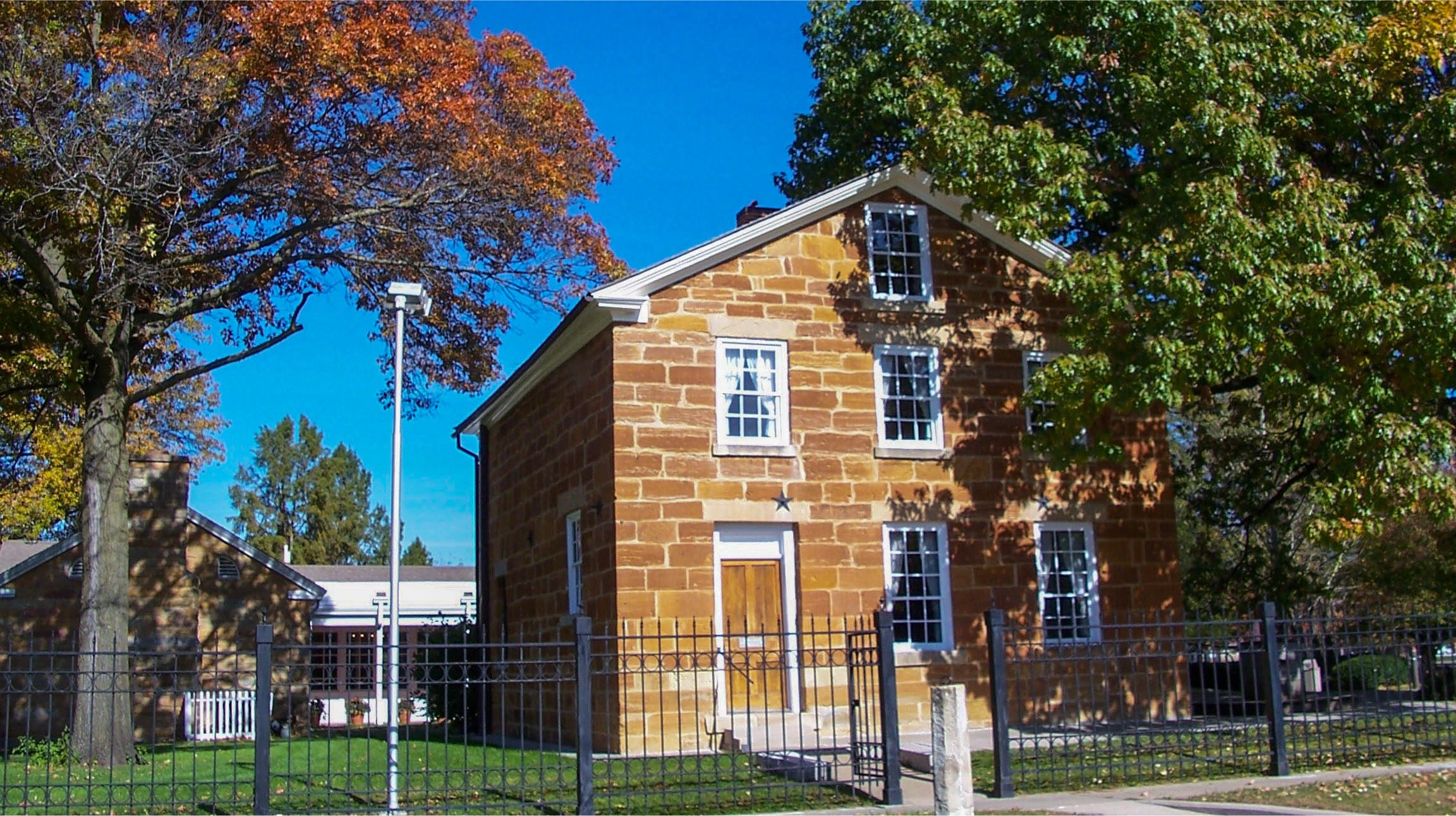305 Walnut Street
Carthage, Illinois
217-357-2989
The old jail in Carthage was the site of the murder of Joseph and Hyrum Smith on June 27, 1844, by a mob of approximately 150 men. The Carthage Jail was built in 1839. The two-story rectangular gable-front building is constructed of native red limestone and measures twenty-nine by thirty-five feet. Like other county jails in Illinois, Carthage Jail was built to incarcerate petty thieves and debtors and to serve as a temporary holding place for violent criminals. The debtor's room was located in the northwest corner of the first floor, and the criminal’s cell was located on the second floor. The jail also included living quarters for the jailer's family that included a kitchen, a dining room, and bedrooms.
In 1844 disaffected members of the Church of the Latter Day Saints joined together to publish a newspaper called the Nauvoo Expositor. Its only issue was published on June 7, 1844 and contained criticisms of Joseph Smith, Jr., leader of the Church and mayor of Nauvoo. The paper caused generated outrage by most of the citizens of Nauvoo and caused the Nauvoo city council to pass an ordinance declaring the newspaper a public nuisance designed to promote violence. The ordinance allowed Smith to order the city marshal to destroy the printing press, which was done on June 10, 1844. Smith’s critics said that he had violated the freedom of the press and legal charges were brought against Smith and others for the destruction of the printing press, including charges of inciting riot and treason. The destruction of the press also brought violent threats against Smith and the Mormon community by the non-Mormon populace in the area. The warrants were dismissed in the court at Nauvoo on a writ of habeas corpus. Smith then declared martial law on June 18 and called out the Nauvoo Legion, an organized city militia of about 5,000 men to protect Nauvoo from outside violence.
The situation brought Illinois Governor Thomas Ford to Carthage. Ford was especially critical of the Mormon religion and had Smith arrested and sent to Missouri to face charges there one time before. On June 23, 1844, Ford wrote a letter to Smith demanding to meet with "well informed and discreet persons," to explain the Mormon position on the destruction of the printing press. The Mormons returned to Nauvoo with a letter from Ford to Smith. Ford explained "your conduct in the destruction of the press was a very gross outrage upon the laws and libels of the people." He also demanded that any and all of the Mormons who were guilty of the destruction of the press come to Carthage and surrender to the law and threatened to use the militia to enforce the law. On June 25, 1844, Joseph and Hyrum Smith, along with the other fifteen city council members and some friends, surrendered to the Carthage constable. The city council members were charged and released on bond but Joseph and Hyrum Smith were charged with treason against the state of Illinois for declaring martial law in Nauvoo, a capital offense, and detained. Two members of the city council, Willard Richards and John Taylor, decided to remain with the Smiths.
Governor Ford left for Nauvoo not long after Smith went to stay at the jail. The anti-Mormon "Carthage Greys", a local militia, were assigned to protect Smith. Before a trial could be held, a mob of about 200 armed men, their faces painted black with wet gunpowder, stormed the jail in the late afternoon of June 27, 1844. The Carthage Greys reportedly feigned defense of the jail by firing shots over the attackers' heads with some joining the mob that who rushed up the stairs to where the Smiths were being held. In the commotion that followed both Joseph and Hyrum Smith were killed, Taylor was wounded and Richards escaped unharmed. The Smiths became martyrs in the eyes of the members of the Church of Latter Day Saints after the incident. The Mormons continued to live in the area for an additional two years before beginning their historic trek to Utah.
The building was used as a jail for 25 years. Over the years the jail had been modified and utilized for different purposes. For a period the jail was home to Carthage College. It was a private home in 1903, when The Church of Jesus Christ of Latter-day Saints bought it for $4,000, making it the first historic property that the church purchased. The Church began restoring the property in 1938. The site, which covers a full city block, contains a historical visitors center that was built in 1963. Tours of the Old Carthage Jail begin at the visitor's center with an 18-minute film that depicts the events of Joseph Smith's life and mission. A tour guide then takes visitors into the Carthage Jail where the first floor parlor, the first floor debtor's prison, the second floor criminal cell, and the second floor bedroom where the Smiths were murdered have been restored to a close approximation of its appearance in 1844. The Carthage Latter Day Saints visitor's center houses art depicting the life of Joseph Smith with tours starting every 15 minutes. The grounds have been landscaped with beautiful gardens and a life-sized statue of Joseph and Hyrum pays tribute to the brothers.
Visiting the Carthage Jail
Visiting Hours
Mid-May – Labor Day: Monday - Saturday: 9 am - 7 pm; Sunday: 10:30 am -6 pm
After Labor Day – Mid-May: Monday – Saturday: 9 am - 5 pm. Sunday: 12:30 pm - 5 pm
There is no fee to visit the Carthage Jail
Explore the community of Carthage













